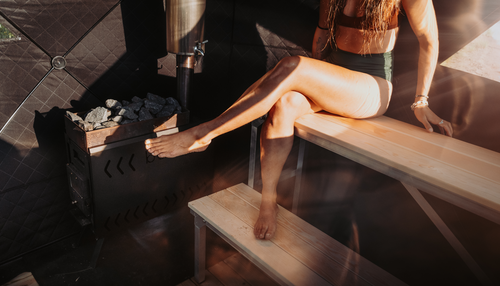New Year offer
Näver
Please fill in your information below to log in.
Don’t have an account?
Don’t have an account?
Already have an account?
We will send you the link to restore the password.
Recent searches


Pouring water over the sauna stones feels completely natural today. But did you know that this tradition goes back thousands of years? Löyly, the heart of sauna culture, has accompanied people in Northern Europe for generations.
In the oldest Finnish smoke saunas, the stones were heated for many hours without a chimney. Once the smoke had cleared, glowing hot stones remained. The water poured over the stones turned into steam – and it was this steam that brought the sauna to life.
The word “löyly” means “spirit” or “soul.” In ancient times, it was considered sacred, a force that could cleanse both body and soul. The sauna was not only a place for warmth and hygiene – it was also the setting for life’s most important moments. Children were born here, people washed and healed themselves here, and the deceased were also washed here before burial. The sauna accompanied a person from their first breath to their last.
In Finland and throughout Northern Europe, the sauna was one of the most central places in the home. It was often regarded as a sacred space where silence, cleansing, and community were just as important as the heat itself. Around löyly, rituals developed: birch twigs dipped in water, herbs that gave the steam its fragrance, and special ceremonies on festive occasions. In this way, the sauna became more than just a room – it became a center for sauna community and tradition.
Today, saunas exist in many different forms, from wood-fired cabins to modern sauna tents. But the act remains the same – pouring water over the hot stones and letting the steam envelop us, just as people did in smoke saunas hundreds of years ago.
Löyly is more than just steam – it is a tradition, a feeling, and a link to history. When you hear the stones sizzle and feel the steam on your skin, you are part of a story that has lived on in Northern Europe for thousands of years.
Pouring water over the sauna stones feels completely natural today. But did you know that this tradition goes back thousands of years? Löyly, the heart of sauna culture, has accompanied people in Northern Europe for generations.
In the oldest Finnish smoke saunas, the stones were heated for many hours without a chimney. Once the smoke had cleared, glowing hot stones remained. The water poured over the stones turned into steam – and it was this steam that brought the sauna to life.
The word “löyly” means “spirit” or “soul.” In ancient times, it was considered sacred, a force that could cleanse both body and soul. The sauna was not only a place for warmth and hygiene – it was also the setting for life’s most important moments. Children were born here, people washed and healed themselves here, and the deceased were also washed here before burial. The sauna accompanied a person from their first breath to their last.
In Finland and throughout Northern Europe, the sauna was one of the most central places in the home. It was often regarded as a sacred space where silence, cleansing, and community were just as important as the heat itself. Around löyly, rituals developed: birch twigs dipped in water, herbs that gave the steam its fragrance, and special ceremonies on festive occasions. In this way, the sauna became more than just a room – it became a center for sauna community and tradition.
Today, saunas exist in many different forms, from wood-fired cabins to modern sauna tents. But the act remains the same – pouring water over the hot stones and letting the steam envelop us, just as people did in smoke saunas hundreds of years ago.
Löyly is more than just steam – it is a tradition, a feeling, and a link to history. When you hear the stones sizzle and feel the steam on your skin, you are part of a story that has lived on in Northern Europe for thousands of years.
Heat between the sessions
After each surf session, they gathered in our Sauna Tent. It became a place to regain warmth, rest their muscles, and talk through what they had just experienced. Maybe even reflect on why they truly chase those perfect waves.
And for us, that's exactly what the sauna is all about. Not just heat – but the rhythm of recovery, performance, and community. A place to land.
That our Sauna Tent got to be part of such a journey – together with some of the world's most dedicated surfers – is something we are incredibly proud of.
Who are they?
Freddie Meadows
is Sweden's most experienced professional surfer. After ten years on the competition scene, he chose to follow his heart and start exploring Scandinavian coastlines – with the goal of finding world-class waves in our northern waters.
Nic von Rupp
Hailing from Portugal, he is known for surfing some of the biggest waves ever at Nazaré. He is a multiple championship winner, documentary filmmaker, and has twice been nominated for the World Surf League's "Big Wave Performance of the Year."
Andrew Cotton
Born in the United Kingdom, he is a pioneer of Big Wave Surfing in Europe. He has towed surfing legends into record-breaking waves, gained global recognition, and pushed the boundaries of what British surfing can be – while balancing his career with life as a parent of young children.


Sauna + surf = an obvious combination
There is something special about the contrast between cold and heat, performance and stillness. The chaos of the waves meets the calm of the tent. And for those who surf in Arctic conditions, the sauna is not a luxury – it is a necessity.
Where will the next wave happen? We don’t know. And we’re not supposed to know. But one thing is certain: our Sauna Tent will be there.